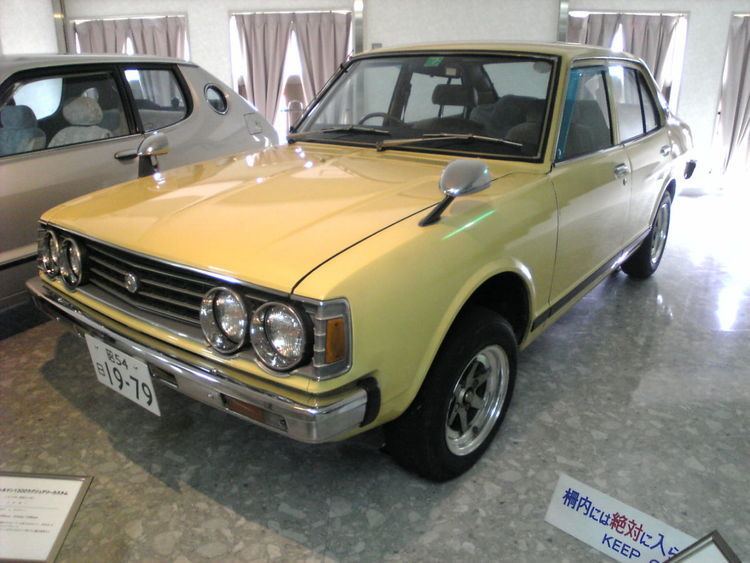Production 1974–1987 | ||
 | ||
Layout Front-engine, rear-wheel drive Related Engine 1166 cc 3K/3K-J OHV I41290 cc 4K-U/4K-J OHV I41453 cc 3A-U SOHC I41407 cc T/T-J OHV I41587 cc 4A SOHC I41588 cc 2T/2T-J OHV I41588 cc 12T-U OHV I4 | ||
The Daihatsu Charmant is a subcompact sedan built by Daihatsu of Japan, based on the Toyota Corolla. It was replaced by the Daihatsu Applause. The Charmant was originally a spin-off of the Toyota Corolla of the 1970s; model changes paralleled those of the Corolla. All Charmants were fitted with Toyota inline-four engines, ranging from 1.2 to 1.6 litres. The word "charmant" is French for charming.
Contents
First generation (1974–1981)
First presented in November 1974, the A35 Charmants, based on earlier Corollas, were normally equipped with 1166 cc engines producing 66 PS (SAE) and 1290 cc engines producing 72 PS (SAE) at 5,200 rpm. This type of engines were coded as 3K (1.2 L) and 4K (1.3 L) Toyota engines and came with a four- or five-speed manual transmission, as well as a two- or three-speed automatic option. The 88 PS (SAE) 1588 cc overhead valve 12T engine was also available from 1978 on; this could also be ordered with a three-speed automatic with overdrive. There was also a 1.4-litre engine available, offering 86 PS (SAE).
In Japan only the 1.2- and 1.4-litre models were originally available, as the A10 and A20. These were replaced by the 1.3 and the 1.6 in April 1978 (A30 and A40), along with minor changes to the exterior and interior, including a new grille and dashboard. A protective side strip was also added. The new engines were the 4K-U and the 2T-U, while the van received the 4K-J (while retaining the T-J) - these engines fulfilled the commercial vehicle emissions specifications. In July an automatic version of the 1.6 appeared.
Unique to the first generation, a station wagon was also available. This was called "Van" in the Japanese domestic market, where it was classed as a commercial vehicle. The Van was introduced in December 1974, a month after the saloons.
This model was exported to a fair number of countries, mostly markets without their own automobile industry. It was the first Daihatsu to be sold in Iceland, where a large number of surplus cars from the Netherlands were brought in the summer of 1979. Sold at a very low price, it was one of Iceland's most popular cars that year.
Second generation (1981–1987)
A new Charmant was launched at the Frankfurt Motorshow in September 1981 with new squarer bodywork that was somewhat outmoded already when being introduced, as was its front-engine, rear-wheel drive layout. The only bodywork available was a five-door saloon.
In Japan, the biggest engine was now an OHC 1.5 L (1,453 cc) with 83 PS (61 kW) at 5,600 rpm. In the export, the 1.6-litre 1.6 L (1,588 cc) 2T engine was also available; power outputs ranged from 76 to 83 PS (56 to 61 kW) depending on compression ratios and intended markets. For the 1984 model year, the larger engine was changed to the overhead cam 4A unit, with an alloy head. Performance improved marginally while the gas mileage was considerably better. The smaller 1.3-litre engine, of 1.3 L (1,290 cc), produced between 62 and 74 PS (46 and 54 kW) depending on market. Trim levels were LC, LE and LGX; these continued until 1987 when the range was discontinued in the United Kingdom and most other export markets. All the engines were carburetted. In Japan, the most luxurious versions (with available climate control) were called "Altair".
The Charmant had an independent front suspension (struts), and a live four-link rear axle. Suspension settings were soft, for maximum comfort. This setup makes the car very desirable for drifting. The car then underwent a minor facelift in autumn 1984.
The Daihatsu Charmant production ended in late 1987, leaving a gap at the top of Daihatsu's lineup. In 1989, the Applause appeared to fill the Charmant's shoes.
